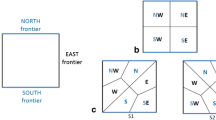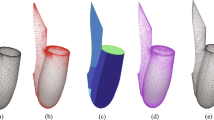Abstract
An automated approach to quadrilateral mesh generation with complex internal geometric feature constraints is presented in this paper. It can deal with all kinds of feature constraints such as internal holes, constraint lines, constraint points, density lines and density points, etc., and satisfy special requirements of mesh generation for numerical analysis. The quadrilateral mesh is generated based on the looping algorithm. As the core of the algorithm, the new splitting criteria are put forward to improve the quality and efficiency of mesh generation. The method of dealing with feature constraints is proposed by considering constraint lines and points, density lines and density points as internal holes with zero area. The method for generating boundary elements is also introduced to improve the element quality around the boundary and feature constraints. For the situation in which feature constraints subdivide the domain into sub-domains, an automatic determination method of sub-domain boundaries is presented. An improved looping algorithm is presented for 3D surface meshing with feature constraints. The determination of proper splitting plane and the handling of feature constraints are put forward. The program of quadrilateral mesh generation has been developed based on the method presented in this paper and successfully applied to mesh generation in several engineering fields.





























Similar content being viewed by others
References
Ho-Le K (1988) Finite element mesh generation methods: a review and classification. Comput Aided Des 20:27–38
Schneiders R (2000) Algorithms for quadrilateral and hexahedral mesh generation. In: Proceedings of the VKI lecture series on computational fluid dynamic, 20–24 March 2000
Yeung SF, Hsu MB (1973) A mesh generation method based on set theory. Comput Struct 3:1063–1077
Durocher L, Gasper A (1979) A versatile two-dimensional mesh generator with automatic bandwidth reduction. Comput Struct 10:561–575
Schneiders R (1996) A grid-based algorithm for the generation of hexahedral element meshes. Eng Comput 12:68–77
Petersen SB, Gouveia BPPA, Rodrigues JMC, Martins PAF (1988) A metal-forming approach to automatic generation of graded initial quadrilateral finite element meshes. Eng Comput 15(5):577–587
Petersen SB, Rodrigues JMC, Martins PAF (2000) Automatic generation of quadrilateral meshes for the finite element analysis of metal forming processes. Finite Elem Anal Des 35:157–168
Liang XH, Ebeida MS, Zhang YJ (2009) Guaranteed-quality all-quadrilateral mesh generation with feature preservation. In: Proceedings of 18th international meshing roundtable, Salt Lake City, UT, October 2009, pp 45–63
Zhang YJ, Bajaj C (2006) Adaptive and quality quadrilateral/hexahedral meshing from volumetric data. Comput Methods Appl Mech Eng 195(9–12):942–960
Blacker TD, Stephenson MB (1991) Paving: a new approach to automated quadrilateral mesh generation. Int J Numer Method Eng 32:811–847
White DR, Kinney P (1997) Redesign of the paving algorithm: robustness enhancements through element by element meshing. In: Proceedings of 6th international meshing roundtable, Albuquerque, NM, October 1997, pp 323–335
Yoshimura S, Wada Y, Yagawa G (1999) Automatic mesh generation of quadrilateral elements using intelligent local approach. Comput Methods Appl Mech Eng 179:125–138
Roger JC, Steven EB (1996) Generalized 3-d paving: an automated quadrilateral surface mesh generation algorithm. Int J Numer Meth Eng 39:1475–1489
Owen SJ, Staten ML, Canann SA (1999) Q-Morph: an indirect approach to advancing front quad meshing. Int J Numer Method Eng 44(9):1317–1340
Sluiter MLC, Hansen DC (1982) A general purpose automatic mesh generator for shell and solid finite elements. Comput Eng 3:29–34
Talbert JA, Parkinson AR (1990) Development of an automatic, two-dimension finite element mesh generator using quadrilateral elements and Bezier curve boundary definition. Int J Numer Method Eng 29:1551–1567
Wu WT, Oh SI et al (1990) Automated mesh generation for forming simulation. In: ASME international computers in engineering conference proceedings, vol 1. ASME, Boston, Massachusetts, August 1990, pp 507–515
Sarrate J, Huerta A (2000) Efficient unstructured quadrilateral mesh generation. Int J Numer Method Eng 49:1327–1350
Joun MS, Lee MC (1997) Quadrilateral finite-element generation and mesh quality control for metal forming simulation. Int J Numer Method Eng 40:4059–4075
Ma XW, Zhao GQ, Sun L (2011) AUTOMESH-2D/3D: robust automatic mesh generator for metal forming simulation. Mater Res Innov 15(s1):S482–S486
Tsvelikh A, Axenenko O (1998) Automatic generation of quadrilateral finite element meshes. Comput Mater Sci 9:367–378
Bastian M, Li B (2003) An efficient automatic mesh generator for quadrilateral elements implemented using C++. Finite Elem Anal Des 39:905–930
Lee KY, Kim II, Cho DY, Kim TW (2003) An algorithm for automatic 2D quadrilateral mesh generation with line constraints. Comput Aided Des 35:1055–1068
Park C, Noh JS, Jang IS, Kang JM (2007) A new automated scheme of quadrilateral mesh generation for randomly distributed line constraints. Comput Aided Des 39:258–267
Sun L, Zhao GQ, Ma XW (2012) Adaptive generation and local refinement methods of three-dimensional hexahedral element mesh. Finite Elem Anal Des 50:184–200
Acknowledgments
This project is supported by Shandong Young Scientists Award Foundation (Grant No. BS2011ZZ008) and State Key Laboratory of Materials Processing and Die & Mould Technology, Huazhong University of Science and Technology.
Author information
Authors and Affiliations
Corresponding author
Rights and permissions
About this article
Cite this article
Ma, X., Zhao, G. An automated approach to quadrilateral mesh generation with complex geometric feature constraints. Engineering with Computers 31, 325–345 (2015). https://doi.org/10.1007/s00366-014-0353-2
Received:
Accepted:
Published:
Issue Date:
DOI: https://doi.org/10.1007/s00366-014-0353-2




